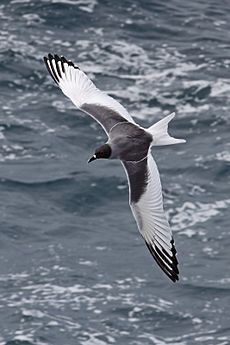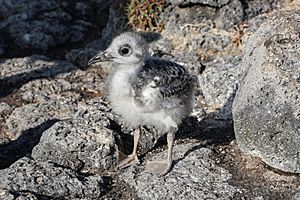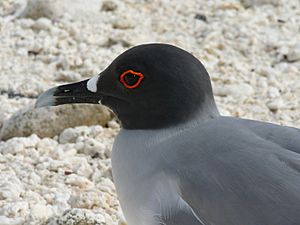Swallow-tailed gull facts for kids
Quick facts for kids Swallow-tailed gull |
|
|---|---|
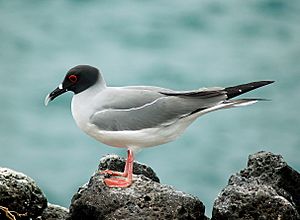 |
|
| On the Galápagos Islands | |
| Conservation status | |
| Scientific classification | |
| Genus: |
Creagrus
|
| Species: |
furcatus
|
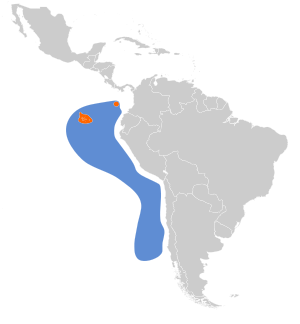 |
|
The swallow-tailed gull (Creagrus furcatus) is a special seabird that lives near the equator. It belongs to the gull family, called Laridae. This bird is the only species in its group, called the Creagrus genus.
Its scientific name, Creagrus, comes from words meaning "hook for meat." This name likely refers to its hooked bill. A French scientist named Adolphe-Simon Neboux first described this bird in 1846. The name furcatus means "two-tined fork," which describes its tail.
Swallow-tailed gulls spend most of their lives flying over the open ocean. They mainly breed in the Galápagos Islands. You can find them on rocky shores and cliffs, especially on Hood, Tower, and Wolf Islands. They are more common on the eastern islands where the water is warmer.
This gull is the only fully night-active gull and seabird in the world. It hunts for squid and small fish at night. These prey animals come closer to the surface when it's dark to feed on tiny ocean creatures called plankton.
Contents
What Does It Look Like?
Male and female swallow-tailed gulls look the same. They don't have different colors or body shapes.
During the breeding season, adult gulls have a black head. They also have a bright red ring of skin around each eye. When it's not breeding season, their head turns white. The red eye ring also becomes black.
Their upper chest is grayish, and their back is gray. Their wingtips are black. The bill is mostly black but has a white tip.
Amazing Night Vision
Swallow-tailed gulls have special eyes to help them hunt at night. Their eyes are larger than those of any other gull. This helps them gather more light.
They also have a special layer at the back of their eye called a tapetum lucidum. This layer reflects light back through the retina. This means more light reaches the cells that detect light, helping them see better in the dark.
Where Do They Live?
The swallow-tailed gull mostly breeds in the Galápagos Islands. A few pairs also nest on Malpelo Island near Colombia.
When they are not breeding, these gulls live completely over the open ocean. They fly and hunt far from land. They also migrate eastward to the coasts of Ecuador and Peru.
How Do They Behave?
Food and Hunting at Night
Swallow-tailed gulls are unique because they only feed at night. They mostly eat fish and squid. These creatures come up to the ocean surface at night to eat plankton.
At dusk, the gulls leave their nesting areas in a group. They make a lot of noise and show off before they fly out to hunt.
Calls and Sounds
The sounds and displays of swallow-tailed gulls are different from other gulls. Their calls are most like those of the black-legged kittiwake and Sabine's gull.
Their loudest and most common call is an alarm sound. It's called a "rattle-and-whistle." It sounds like a gurgling scream, and the bird moves its head from side to side. If one bird makes this call, others often join in, even if they don't see what caused the alarm.
When mates greet each other, they make a loud and fast kweek, kweek, kweek sound. They curve their head and neck forward towards the ground while doing this.
Breeding and Life Cycle
Swallow-tailed gulls start breeding when they are about 5 years old. Pairs often stay together for many years. They usually breed all year round in large groups with other seabirds. They nest on cliffs in the Galápagos Islands, sometimes on flat areas.
They find food for their young in the seas close to their nesting spots. The nest is built on a small platform on a cliff. It's usually less than 10 meters above the sea. They cover the rocky ground with small pieces of lava, white coral, and sea urchin spines. This stops the egg from rolling away.
Nesting birds often face the cliff. This is common for gulls that only nest on cliffs, like the black-legged kittiwake. The female usually lays one speckled egg at a time.
These gulls can breed at any time of the year. They follow a nine-month cycle. If an egg or chick doesn't survive, they might breed again sooner. The egg usually hatches after 31 to 34 days.
A young gull takes its first flight when it's about 60 to 70 days old. The parents feed it until it's about 90 days old. Then, it leaves the land, possibly with its parents, to live over the open seas.
How Many Are There?
Scientists don't think the swallow-tailed gull is in danger. The last count in 2004 estimated there were about 35,000 of these birds.
See also
 In Spanish: Gaviota de las Galápagos para niños
In Spanish: Gaviota de las Galápagos para niños



